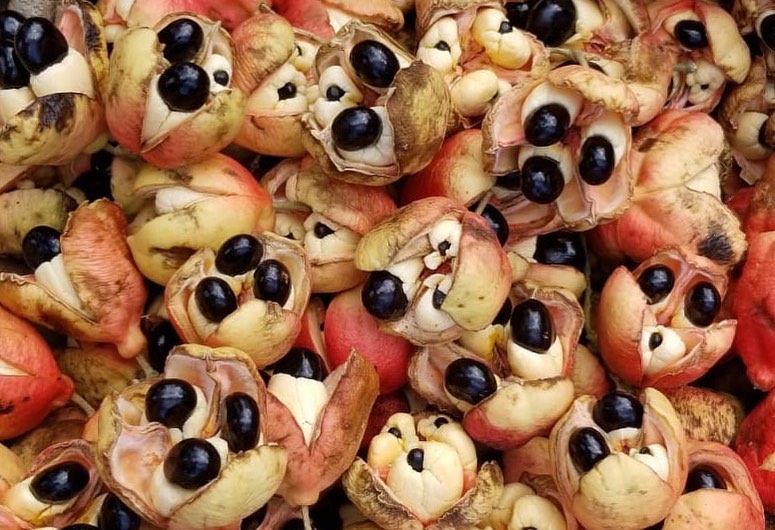There are a lot of strange foods in the world. From the infamous and stinky durian fruit to live octopus — yeah, people really that. Some foods are actually so bizarre that the United States government has been forced to ban them outright. From bizarre-sounding meats to beverages that could make you hallucinate, we’ve found 16 foods that are officially banned from some, if not all, of the 50 states in the U.S.
If you think the U.S. has a somewhat normal relationship with food, think again. Sure, we like our McDonald’s hamburgers and our Hood milk, which are both staples of the American diet. But did you know there was a time when we were eating horses? And yup, we were drinking unpasteurized milk up until the last century.
If you’re still blissfully unaware of what our grandparents (and parents) were eating as recent as the 1960s, then it’s time to wake up.
Americans were eating tuna-berry sandwiches less than a century ago, people. To be fair, the foods that the U.S. government has banned are much more offensive than tuna-berry sandwiches, if you can believe it. Some of the “delicacies” listed below may just make your stomach churn, so we hope you don’t have dinner plans lined up.
1. Horse Meat
Consuming horse meat is not technically illegal in the United States.
And it was a totally normal thing to eat up until the mid-20th century. But it’s nearly impossible to purchase now. Up until 2007, there were horse slaughterhouses scattered across the country that mainly exported horse meat to Europe.
Fortunately…
Congress passed a measure that ultimately banned funding for the United States Department Of Agriculture (USDA) to inspect horse slaughterhouses. Therefore, there’s no slaughtering and no consumption of horses happening in the U.S., nor will there be any time soon.
2. Haggis
Let’s talk about “sheep’s pluck.”
Traditional Scottish haggis, that being a savory pudding made of “sheep’s pluck,” AKA sheep heart, liver, and lungs, has been banned in the U.S. since 1971. The USDA actually ruled that “livestock lungs shall not be saved for use as human food,” due to the reported fear of the sheep-borne disease “Scrapie,” which attacks the animals’ central nervous system.
3. Kinder Surprise Eggs
Kinder Surprise Eggs were banned in the U.S. because of a choking hazard.
They contained a small, inedible toy in the center of their chocolate shell. As NPR reported in 2017, the Kinder Surprise Egg was considered a choking hazard due to the mix of edible and non-edible parts.
But this doesn’t mean people haven’t tried smuggling Kinder Eggs into the U.S.
In 2015 alone, about 30,000 Kinder Surprises were confiscated by U.S. Customs. So yes, people do take their Kinder Surprise Eggs very seriously.
4. Absinthe
It an take those who drink it on a hallucinative trip to see the “green fairy.”
A chemical compound called thujone is responsible for these trips and thus caused massive controversy that ultimately led to the ban of absinthe in the U.S. However, due to some prior shady science, the U.S. gave absinthe another shot in the ’90s, and in 2007, the government allowed the importation so long as the absinthe contained less than 100 parts per million of thujone.
5. Shark Fin
Shark fin is considered a delicacy in many Asian cuisines.
It is often added to soups and broths to boost flavor. However, 12 U.S. states have banned the sale of shark fin due to the inhumane way shark fins are obtained — they’re cut off live sharks, who are then tossed back into the ocean and oftentimes die, unable to swim properly without their dorsal.
We imagine that this is a very sad sight.
The shark finning industry is putting numerous shark species in danger of extinction, which is definitely not cool.
6. Pig’s Blood Cake
In Taiwan, pig’s blood cake, which is made with pig’s blood and sticky rice, is a steamed snack usually served on a wooden skewer.
Its availability in the U.S. is actually debated about with some reports from Taiwan stating that it has been banned by the USDA, but it seems to be just a rumor started by a Taiwanese reporter based in Los Angeles.
“I’m not aware of any formal ban,”
Terrance Powell, bureau director of Specialized Surveillance & Enforcement Bureau of Los Angeles County Department of Public Health, told LAWeekly in 2011. “Our concern is that it is cooked to standards as far as temperature and under sanitary conditions. As long as those guidelines are followed, there is no issue with it.”
7. Casu Marzu
Casu marzu is reportedly the most dangerous cheese in the entire world.
It hails from the Italian island of Sardinia and is traditionally made with sheep’s milk, and if prepared properly, casu marzu will contain thousands of live maggots — which is why it’s banned in the U.S. Nice.
To make casu marzu, one must first heat the sheep’s milk and then let it sit for about three weeks to allow it to curdle. The crust is then cut off, thus inviting flies to enter the cheese and lay their eggs.
Once that happens, the cheese is left in a dark area for about two or three months.
During that time, the eggs hatch into larvae and begin to eat the rotting cheese. It’s the larvae’s excrement that creates the soft texture and richness of the casu marzu. It’s so questionable that the EU European Food Safety Authority has even banned it. Seriously… who comes up with this stuff?
8. Puffer Fish
Puffer fish, known as “fugu” in Japan, is banned in the U.S.
That’s because it “may contain the potent and deadly toxins tetrodotoxin and/or saxitoxin which can cause severe illness and death,” as reported by the Food and Drug Administration (FDA). The toxin is most commonly found in the fish’s liver, gonads, intestines, and skin, and if the fish is not prepared correctly by way of freezing or cooking, the toxin can kill within two hours of consumption.
9. Unpasteurized Milk
Unpasteurized milk, also called raw milk, is currently banned in 20 U.S. states.
When pasteurization, the process of partial-sterilization to thwart the spread of bacteria and harmful pathogens, became a thing in the late 19th century, people realized that drinking raw milk posed a threat to consumer health.
Do you trust it?
Even so, many people today believe that current farm sanitation standards make unpasteurized milk safe to drink.
10. Ackee Fruit
Your tummy isn’t going to like this one.
The FDA banned the ackee fruit, native to West Africa, Central America, and the Caribbean, because it contains the toxin hypoglycin A. When not ripened fully, the fruit contains high levels of hypoglycin A, which, if consumed, can cause severe vomiting, hypoglycemia, drowsiness, muscular exhaustion, prostration, and even coma and/or death.
11. Sassafras Oil
This was commonly used as flavoring in tea and root beers.
It was banned by the FDA in 1979 after it was found to cause cancer in rats. “While the amount of sassafras that could potentially cause cancer in humans remains unknown, one cup of strong sassafras tea is reported to contain as much as 200 mg of safrole, an amount that is four times higher than the amount considered potentially hazardous to humans if consumed regularly,” Blue Shield claims via EverydayHealth.
12. Mirabelle Plums
This one is… unclear.
Mirabelle plums are reportedly a protected species from Lorraine, France, that are not allowed to cross into the U.S. due to some strange, unclear import laws. However, seeds have been smuggled and there are some Mirabelle plum trees scattered throughout the states. Naughty, naughty, smugglers!
13. Wild Beluga Caviar
Protect the fish!
Beluga caviar, which are the eggs from the wild beluga sturgeon harvested from the Caspian Sea basin, is an exotic food enjoyed in some nations, but is banned from the United States.
Because the demand for beluga caviar got so high back in the early 2000s, beluga was threatened with extinction.
Therefore, in 2005, the U.S. Fish and Wildlife Service banned the import of wild beluga caviar.
14. Redfish
See above.
After New Orleans chef Paul Prudhomme shared his recipe for blackened redfish in 1980, the rare North American fish became so popular that the species all of the sudden was endangered by the middle of the decade.
In 1986, the Commerce Department shut down all redfish fisheries and limited sales to help the redfish population to rebuild.
As of today, redfish is banned in all U.S. states except Mississippi.
15. Queen Conch
Wow. Sea creatures are really getting the short end of the stick.
“Queen conch meat is consumed domestically throughout the Caribbean and exported as a delicacy,” according to the U.S. Fish and Wildlife Service International Affairs website.
“Their slow growth, occurrence in shallow waters and late maturation make queen conch particularly susceptible to over-fishing, their greatest threat.”
Queen conch became an endangered species in the 1970s, and as of today, it is still illegal to commercially or recreationally harvest queen conch in the state of Florida.
16. Foie gras
One of the most recent foods on the to-ban list is foie gras.
And the delicacy is actually fatty duck liver. In 2004, California passed a law banning the sale and production of foie gras, arguing that the current way producers fatten up ducks via a feeding tube called a gavage is inhumane.
After being tossed back and forth from court to court since then, the ban on foie gras was officially reinstated in January 2019.
California may be setting the tone for other states when it comes to foie gras and it will be interesting to see if other states follow suit with a ban on the controversial dish.

